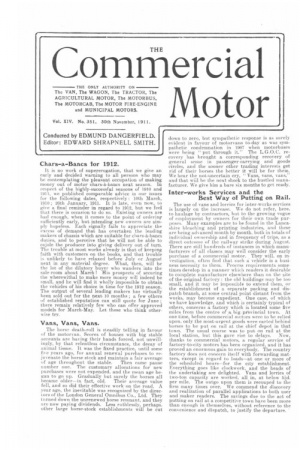Chars-a-Bancs for 1912.
Page 1

If you've noticed an error in this article please click here to report it so we can fix it.
It is no work of supererogation, that we give an early and decided warning to all persons who may be contemplating the pleasant occupation of making money out of motor chars-à-banes next season. In respect of the highly-successful seasons of 1910 and 1911, we published comparable advice in our issues for the following dates, respectively : 10th March, 1910; 20th January, 1911. it is late, even now, to give a final reminder in regard to 1912, but we feel that there is occasion to do so. Existing owners are bail enough, when it comes to the point of ordering sufficiently early, but intending new owners are simply hopeless. Each signally fails to appreciate the excess of demand that has overtaken the leading makers of chassis which are suitable for chars-a-banes duties, and to perceive that he will not be able to cajole the producer into giving delivery out of turn. The trouble at most works already is that of keeping faith with customers on the books, and that trouble is unlikely to have relaxed before July or August next in any material degree. What, then, will be the lot of the dilatory buyer who wanders into the sale-room about March? His prospects of securing the wherewithal to make more money will indeed be small, and he will find it wholly impossible to obtain the vehicles of his choice in time for the 1912 season. The output of several leading makers has Virtually been sold out for the next 10 months; a few others of established reputation can still quote for June ; there remain relatively few who can offer approved models for March-May. Let those who think otherwise try.
Vans, Vans, Vans.
The horse death-roll is steadily telling in favour of the niotorva.n. Scores of houses with big stable accounts are having their hands forced, not unwillingly, by that relentless circumstance, the decay of animal tissue. It was the fixed practice, until some five years ago, for annual renewal purchases to rejuvenate the horse stock and maintain a fair average
of age throughout the stable. Then came pause number one. The customary allocations for new purchases were not expended, and the mean age began to go up. Gradually but surely the horses all became older—in fact, old. Their average value fell, and so did their effective work•on the road. A year ago, the inevitable was recognized by the directors of the London General Omnibus Co., Ltd. They turned down the unrenewed horse remnant, and they are now paying dividends. Less ruthlessly, perhaps, other large horse-stock establishments will be cut
down to zero, but sympathetic response is as surely evident in favour of motorvans to-day as was sympathetic condemnation in 1907 when motorbuses were being " put through it." The L.G.O.C. recovery has brought a corresponding recovery, of general sense in passenger-carrying and goods circles, and the sooner other trading interests get rid of their horses the better it will be for them. We hear the not-uncertain cry, " Vans, vans, vans," and that will be the next shock to the hustled manufacturer. We give him a bare six months to get ready.
Inter-works Services and the Best Way of Putting on Rail.
The use of vans and lorries for inter-works services is largely on the increase. We do not refer, here, to haulage by contractors, but to the -growing vogue of employment by owners for their own trade purposes. Many examples are to be found in the Lancashire bleaching and printing industries, and these i are being advanced month by month, both n totals of individual ownership and in frequency of trips, as a direct outeome of the railway strike during August. There are still hundreds of instances in which manufacturers of all classes may well consider the early purchase of a commercial motor. They will, on investigation, often find that such a vehicle is a business necessity to them. Process requirements sometimes develop in a manner which renders it desirable to complete manufacture elsewhere than on the site of the original factory : the old buildings may be too small, and it may be impossible to extend them, or the establishment of a separate packing and dispatch branch, at some central point distant from the works, may become expedient. One case, of which we have knowledge, and which is certainly typical of others, concerns a factory which is located some five miles from the centre of a big.prbvincial town. At one time, before commercial motors were to be relied upon, only the most-urgent goods were carted behind horses to be put on rail at the chief depot in that town. The usual course was to put on rail at the
local station, but this gave rise to delays. Now, thanks to commercial motors, a regular service of factory-to-city motors has been organized, and it has proved an enormous gain to everybody. The country factory does not concern itself with forwarding matters, except in regard to loads—at one or more of the scheduled hours---for the city establishment. Everything goes like clockwork, and the heads of the undertaking are delighted. Vans and lorries of two-ton capacity are worked, all in, at below 5id. per mile. The outgo upon them is recouped to the firm many times over. We commend the discovery and realization of parallel applications to both user and maker readers. The savings due to the act of putting on rail at a competitive town have been more than enough in themselves, without reference to the convenience and dispatch, to justify the departure,




















